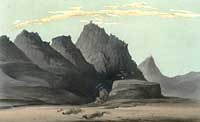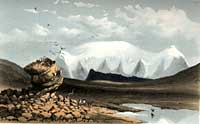An Artist in Iceland
'Hard riding, rain and cold, scanty diet and the ground for a couch.' Thus the English clergyman, teacher and eccentric Sabine Baring-Gould (1834-1924) announced his departure as he set off in 1862 by horse on an adventurous exploration of Iceland.
In Iceland, Its Scenes and Sagas (1863) he described his experiences. His account is fascinating not only in its observations but in the detail of his preparations and expenditure, with supplies ranging from Arnica for saddle sores to opera glasses for observation.


Kálfs-Tindar (left) and Geitlands-Jökull (right)
Baring-Gould, who is probably best known today as author of the hymn 'Onward Christian Soldiers', was a prolific writer with a strong interest in folk culture. His Songs of the West (1899) became a model in the collection of folk ballads.
Before his Iceland trip, he had already written a novel based on the Northern sagas, The Icelander's Sword (1858). His intention in visiting Iceland was 'to examine the scenes famous in Saga and to fill a portfolio with water-colour sketches', but as always his curiosity led him into many strange encounters.
Baring-Gould's images of Icelandic sites are among the most striking of the illustrated travels. In his watercolours of Kálfs-Tindar, Hlithar-Fjall and Geitlands-Jökull we see both the bleakness and beauty of the countryside.
Öxnadals-Heithi was sketched close to midnight, when 'the sun, shining through vapour, lighted the peak with a nebulous glow'.

Öxnadals-Heithi
Next: Icelandic dress